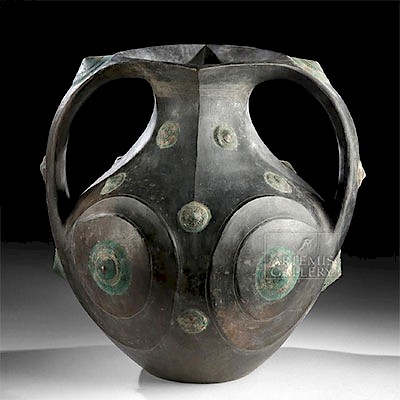Rare Chandraketugarh Pottery Plaque of Goddess - Yakshi
Lot 92c
About Seller
Artemis Fine Arts
686 S Taylor Ave, Ste 106
Louisville, CO 80027
United States
Selling antiquities, ancient and ethnographic art online since 1993, Artemis Gallery specializes in Classical Antiquities (Egyptian, Greek, Roman, Near Eastern), Asian, Pre-Columbian, African / Tribal / Oceanographic art. Our extensive inventory includes pottery, stone, metal, wood, glass and textil...Read more
Categories
Estimate:
$900 - $1,400
Absentee vs Live bid
Two ways to bid:
- Leave a max absentee bid and the platform will bid on your behalf up to your maximum bid during the live auction.
- Bid live during the auction and your bids will be submitted real-time to the auctioneer.
Bid Increments
| Price | Bid Increment |
|---|---|
| $0 | $25 |
| $300 | $50 |
| $1,000 | $100 |
| $2,000 | $250 |
| $5,000 | $500 |
| $10,000 | $1,000 |
| $20,000 | $2,500 |
| $50,000 | $5,000 |
| $100,000 | $10,000 |
| $200,000 | $20,000 |
About Auction
By Artemis Fine Arts
Jul 11, 2019
Set Reminder
2019-07-11 10:00:00
2019-07-11 10:00:00
America/New_York
Bidsquare
Bidsquare : Ancient / Ethnographic / Americana
https://www.bidsquare.com/auctions/artemis-gallery/ancient-ethnographic-americana-4246
Discover ancient art from Egypt, Greece, Italy, and the Near East, as well as Asian, Pre-Columbian, Tribal, Fossils and Fine Art. Also featuring a wonderful collection from a prominent New York estate whose owners reside in the Van Wyck family's historic Lloyd Harbor waterfront home. Artemis Fine Arts info@artemisgallery.com
Discover ancient art from Egypt, Greece, Italy, and the Near East, as well as Asian, Pre-Columbian, Tribal, Fossils and Fine Art. Also featuring a wonderful collection from a prominent New York estate whose owners reside in the Van Wyck family's historic Lloyd Harbor waterfront home. Artemis Fine Arts info@artemisgallery.com
- Lot Description
Central Asia, eastern India, Bengal, Chandraketugarh, ca. 2nd century BCE to 1st century CE. A mold-formed pottery plaque depicting a goddess known as a Yakshi (or Yakshini), a semi-divine deity who is regarded as a nature spirit as well as an attendee of Kubera, the Hindu god of wealth. The figure is defined by her voluptuous chest centered between two bent arms, one of which bearing enormous wrist bands and both bedecked in raised dots indicative of jewels or other finery, and grand concentric circular earrings rest above an intricate necklace replete with hanging cones. Ovoid eyes, a triangular nose, full lips, and a puffy chin constitute her serene visage, and her brow is capped with an elaborate headdress bearing dozens of small jewels. Further raised dots encircle the outer periphery and surround the goddess with an opulent framework. A rare example from ancient India! Custom museum-quality display stand included. Size: 4" W x 4.5" H (10.2 cm x 11.4 cm); 7.1" H (18 cm) on included custom stand.
For an example of a mold used to make figural plaques like this one, please see the Ashmolean Museum of Art and Archaeology, University of Oxford, accession number EA1993.35: http://collections.ashmolean.org/object/357340
Provenance: private Hawaii, USA collection
All items legal to buy/sell under U.S. Statute covering cultural patrimony Code 2600, CHAPTER 14, and are guaranteed to be as described or your money back.
A Certificate of Authenticity will accompany all winning bids.
We ship worldwide and handle all shipping in-house for your convenience.
#141319This is a fragment of a larger pottery plaque. Small chips to face, body, headdress, framework, and peripheries, with minor softening to some finer details, and light encrustations. Nice earthen deposits throughout.Condition
- Shipping Info
-
All shipping is handled in-house for your convenience. Your invoice from Artemis Gallery will include shipping calculation instructions. If in doubt, please inquire BEFORE bidding for estimated shipping costs for individual items.
-
- Buyer's Premium



 EUR
EUR CAD
CAD AUD
AUD GBP
GBP MXN
MXN HKD
HKD CNY
CNY MYR
MYR SEK
SEK SGD
SGD CHF
CHF THB
THB














